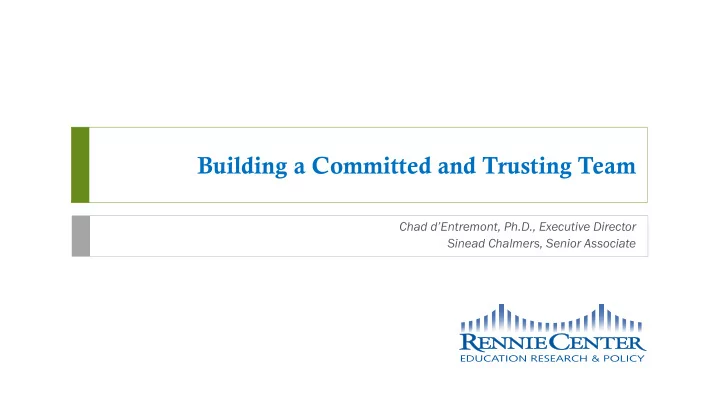

Building a Committed and Trusting Team Chad d’Entremont, Ph.D., Executive Director Sinead Chalmers, Senior Associate
Agenda ▪ Welcome ome and Introd oducti uctions ons ▪ How to build a fruit salad ▪ The Imp mpor orta tance nce of Collaborati oration ▪ Research & Evidence ▪ Steppi ping ng Up Up & Steppin ing g Back ck ▪ The Act of Listening ▪ Finding Empathy for Others ▪ Core Elemen ents ts of Effecti ective Teams ms ▪ Rennie Center Teaming Rubric ▪ Closing sing Reflecti ection ons ▪ Additional resources 2
Mass Production Industrial Model • Divide Complex Knowledge into Simple Parts • Create Narrow Standards for Each Part • Separate classes of employees: Thinkers & Doers Management Thinks S Labor Does (Taylor, 1913)
From the Individual to the Team From To ✓ Interest-Based Position-Based ✓ Collaborative Competitive ✓ Mutual gain Win-Lose
Positional Negotiations Positions Team A Team B
Partnership-based practice Options Options Team A Team B Options Options
Collaboration is a process through which stakeholders who see parts of the problem differently can explore these differences and construct solutions that are better than what they could achieve alone.
ABC Unified School District • 30 schools • 1,100 Educators • 21,000 Students • 46% Reduced/Free Lunch (Rubinstein & McCarthy, 2014)
Level of Partnership Density 69% Density (Rubinstein & McCarthy, 2014)
Level of Communication Frequency (Rubinstein & McCarthy, 2014)
▪ Statistically Significant: P< .01 ▪ Controls for SES ▪ Explains 54% of Variation in API Improvement (Rubinstein & McCarthy, 2014)
Benefits of strong partnerships 1. Quality of Decisions 2. Quantity of Solutions 3. Focus on Implementation 4. Greater Motivation through Voice
Listening simulation
True False Need More Info Three boys were jogging down a country road. They looked in a window and saw people arguing. A husband and wife were having an argument. Broken pieces of pottery were on the floor. The Telephone rang 3 times. A neighbor was on the phone.
Seek First to Understand Then to be Understood
The Purpose of Communication is Understanding But Understanding is Blocked by Filters or Screens Filters or Screens Message Bias Perceptions Prejudice Culture Values Background Receiver Needs Education Sender Goals Experience Wants Assumptions Feedback
Effective Communication • Can you tell me more? Encouraging • When did this happen? Clarifying • Let me see if I understand you. Summarizing • I see that you are frustrated. Acknowledging • I want your advice about this. Soliciting
Killer Phrases • Been there, done that. • Don’t… Can’t… Won’t… • It’ll never work.
“Plans are essential, but the PROCESS of planning, where ideas are hashed out, is critical.” (Participant statement from independent evaluation of the DCP)
Peer-to to-Peer • What are you organization’s strengths? • Where might your organization struggle?
Building a Team Structure ➢ Establish a compelling purpose (PoP) ➢ Clearly define roles and responsibilities ➢ Compose diverse team with intention ➢ Generate team norms ➢ Create space and time to meet and learn
Activity: Teaming Rubric
Share Out • Were there certain prompt questions that resonated strongly with you? • If yes, why? • What factors did you take into account when deciding on a rating? • What are some strategies you could use to build upon strengths and improve upon weaker areas? • Was there anything from the day, so far, that will help your work on this topic?
Improving Education Together offers a thoughtful and actionable road map for creating the schools our children deserve and our society needs. — AMY C. EDMONDSON , NOVARTIS PROFESSOR OF LEADERSHIP AND MANAGEMENT, HARVARD BUSINESS SCHOOL
Recommend
More recommend